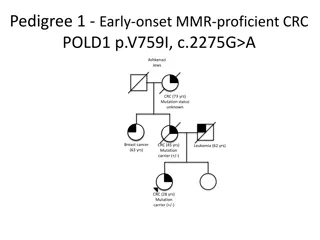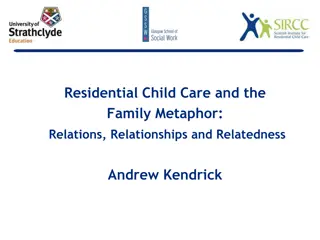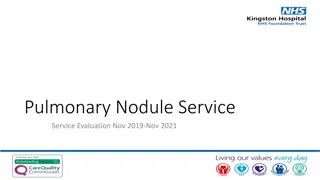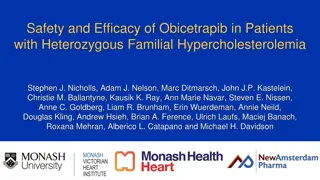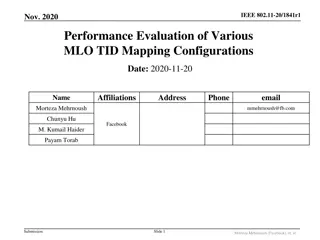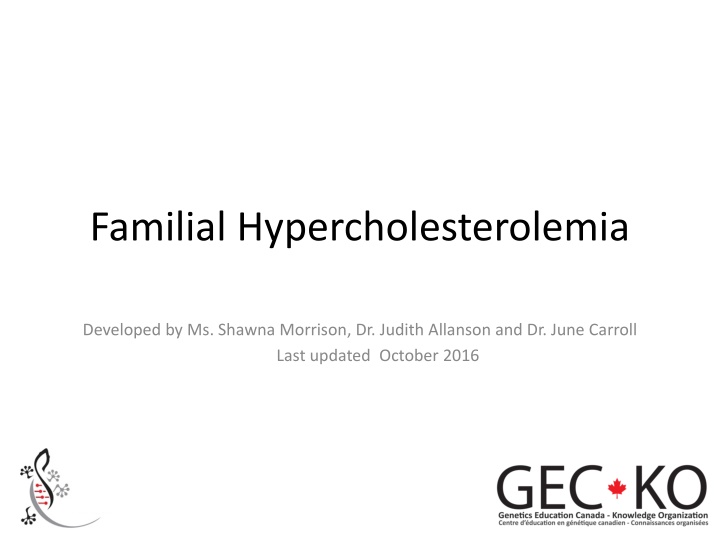
Familial Hypercholesterolemia and Case Study: Jason
Familial Hypercholesterolemia is an autosomal dominant disorder with increased cardiovascular disease risk. Early diagnosis is crucial for effective treatment. Jason, a healthy 38-year-old male, presents with bilateral heel pain and a family history of heart attack. Learn more about this genetic condition and its impact on individuals like Jason.
Download Presentation

Please find below an Image/Link to download the presentation.
The content on the website is provided AS IS for your information and personal use only. It may not be sold, licensed, or shared on other websites without obtaining consent from the author. If you encounter any issues during the download, it is possible that the publisher has removed the file from their server.
You are allowed to download the files provided on this website for personal or commercial use, subject to the condition that they are used lawfully. All files are the property of their respective owners.
The content on the website is provided AS IS for your information and personal use only. It may not be sold, licensed, or shared on other websites without obtaining consent from the author.
E N D
Presentation Transcript
Familial Hypercholesterolemia Developed by Ms. Shawna Morrison, Dr. Judith Allanson and Dr. June Carroll Last updated October 2016
Disclaimer This presentation is for educational purposes only and should not be used as a substitute for clinical judgement. GEC-KO aims to aid the practicing clinician by providing informed opinions regarding genetic services that have been developed in a rigorous and evidence-based manner. Physicians must use their own clinical judgement in addition to published articles and the information presented herein. GEC-KO assumes no responsibility or liability resulting from the use of information contained herein.
Objectives Following this session the learner will be able to: Identify and appropriately refer individuals who may benefit from consultation with lipid specialist and/or genetic consultation Discuss and address patient concerns regarding family history of familial hypercholesterolemia Find high quality genomics educational resources appropriate for primary care
Familial Hypercholesterolemia Pearls Common autosomal dominant disorder resulting in 20x increased risk of cardiovascular disease CVD) and death Early diagnosis and treatment (statin+) can normalize life expectancy Cascade screening of family members allows for early identification and treatment of at-risk individuals Key features: Elevated LDL-C [ 5mmol/L with other features] Early onset CVD (<55 years in men, <65 years in women) Cholesterol deposition in the tendons (xanthomata) Arcus cornealis onset <45years Family history of early onset CVD or hyperlipidemia requiring treatment
Case 1: Jason A healthy 38-year-old male He has been training for half marathon Motivated by his brother s heart attack and death at age 42 years, about 6 months ago Complaining of bilateral heel pain Wondering if he sustained an injury during training Excellent health Non smoker Social drinker (~ 10/week) Healthy BMI No medications Case: NCHPEG
Case 1: Jason 64 66 MI @50y HTN IDDM Treated for dyslipidemia d.42 38 39 MI @42y Jason Case: NCHPEG
What is familial hypercholesterolemia? Familial hypercholesterolemia (FH) is an autosomal dominant genetic condition The uptake of low-density lipoprotein cholesterol (LDL-C) into cells is either decreased or inhibited Results in lifetime exposure to very high levels of LDL-C FH is the most common genetic disorder causing premature cardiovascular disease and death in both men and women At least 1 in 500 Canadians is thought to have FH More common in certain populations due to founder effects (e.g. 1/270 in French Canadians, 1/67 in Ashkenazi Jews) FH is underdiagnosed: estimated <15% of affected Canadians have been diagnosed
What do I need to know about the genetics of familial hypercholesterolemia? Most cases (80-90%) of FH are caused by mutations in the LDL receptor gene LDLR Can be present in a heterozygous form (HeFH) Where an individual has a mutation in one copy of a FH- causing gene Can be present in a homozygous form (HoFH) Where an individual has a mutation in both copies of a FH-causing gene All individuals with HoFH have an extremely high risk of early onset cardiovascular disease
Clinical features of familial hypercholesterolemia Clinical features HeFH HoFH Mutation in both copies of a FH gene Genetics Mutation in one FH gene 5mmol/L with at least one of the additional features (see below) >12 mmol/L lower LDL-C levels, especially in children or in treated patients, do not exclude dx <20 years of age (can be as early as the first year of life) LDL-C levels Cardiovascular disease onset <55 years of age in men <65 years of age in women Cholesterol deposits in the tendons (xanthomata) and/or around the eyes (xanthelasma) Arcus cornealis (white, grey, or blue opaque ring in the corneal margin) onset <45years Physical findings Early onset CVD Hyperlipidemia, often requiring treatment Family history
Familial hypercholesterolemia Red Flags which should prompt specialist referral Likelihood of FH diagnosis Possible LDL-C 5mmol/L AND at least one other red flag LDL-C 5mmol/L AND 2 other red flags Probable Personal or family history of clinical stigmata of FH Personal or family history of premature CVD Family history of significant hypercholesterolemia, often requiring treatment
Who should be offered genetic testing? Heterozygous FH (HeFH) Individuals meeting FH definite or probable or possible diagnostic criteria First-, second- and third-degree family members of an individual with a known mutation in an FH gene Homozygous FH (HoFH) Individuals where both parents have known mutations in FH causing genes (at 25% risk for HoFH) OR An untreated LDL-C >12mmol/L or treated LDL-C 8mmol/L *lower LDL-C levels do not exclude HoFH, especially in children or in individuals who are treated for hyperlipidemia WITH either Cutaneous or tendon xanthomata before age 10 years OR Both parents have elevated LDL-C levels consistent with HeFH
Diagnosis of familial hypercholesterolemia The Canadian Cardiovascular Society (CCS) recommends using those published by the Dutch Lipid Clinic Network
Cascade screening and familial hypercholesterolemia The most cost-effective approach for identification of new FH Screen first-, second- and third-degree relatives of the first individual with a confirmed diagnosis (known as the indexcase) Screening can be done by: Genetic testing for a known familial gene mutation LDL-C measurements Use of diagnostic criteria
What do the genetic test results mean? Positive test result: Pathogenic gene mutation found Confers a definite diagnosis ~100% of individuals will develop hypercholesterolemia Individuals with HeFH have a 20-fold higher risk of premature CVD Untreated, a fatal or non-fatal coronary event will occur in about 50% of males by age 50 and about 30% of females by age 60 Offers the opportunity for cascade screening (1st, 2nd, 3rd degree relatives)
What do the genetic test results mean? Negative test results Familial mutation not found True negative No further testing indicated Reassurance for offspring
What do the genetic test results mean? Negative test results Affected individual, no mutation identified and no known familial mutation This result is uninformative For individuals who meet definite, probable or possible FH criteria FH diagnosis is not ruled out Chance of diagnosis based on Dutch Lipid Network Clinic Chance of finding a gene mutation Definite 70% Probable 29% Possible 11%
Surveillance and Management MEDICATIONSAND HEALTHY LIFESTYLE Statins are the drug class of choice Observational studies have shown a dramatic decrease in cardiac events in statin-treated individuals The CCS recommends a >50% reduction of LDL-C from baseline beginning at age 18 as primary prevention and that an ideal goal of LDL-C <2.0mmol/L is recommended for secondary prevention Refer to specialist if statin therapy alone is insufficient for LDL-C reduction
Case 1: Jason A healthy 38-year-old male Complaining of bilateral heel pain 64 66 MI @50y HTN IDDM Treated for hyperlipidemia d.42 38 39 MI @42y Jason Case: NCHPEG
Case 1: Jason On examination: You notice yellowish bumps over knuckles Jason reports the size and number have been increasing He also reports that his father has the same bumps Case: NCHPEG Image: Genest Can J Cardio 2014
Case 1: Jason On examination: Tenderness over Achilles tendons Apparent thickening of tendons Papulonodular changes like on hands Case: NCHPEG Image: Genest Can J Cardio 2014
Case 1: Jason Jason has evidence of xanthoma on hands and feet Family history of premature CVD Family history of significant hypercholesterolemia LDL-C is ordered. LDL-C = 6.9mmol/L Definite diagnosis of familial hypercholesterolemia Begin statin treatment Refer to lipid specialist and genetic specialist Screen family members (1st, 2nd, 3rd degree)
Familial Hypercholesterolemia Pearls Common autosomal dominant disorder resulting in 20x increased risk of cardiovascular disease CVD) and death Early diagnosis and treatment (statin+) can normalize life expectancy Cascade screening of family members allows for early identification and treatment of at-risk individuals Key features: Elevated LDL-C [ 5mmol/L with other features] Early onset CVD (<55 years in men, <65 years in women) Cholesterol deposition in the tendons (xanthomata) Arcus cornealis onset <45years Family history of early onset CVD or hyperlipidemia requiring treatment




